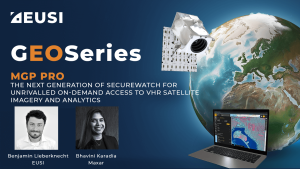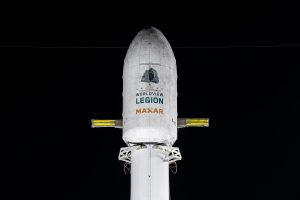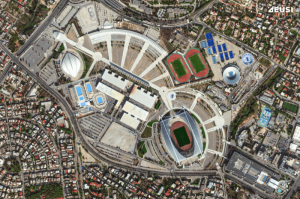European Space Imaging Completes EU Commission Campaign in Record Time
- European Space Imaging
- 10 September, 2013
European Space Imaging has successfully completed another year’s CwRS campaign in record time supplying almost cloud-free imagery well inside collection windows in keeping with their reputation for speedy delivery of high-quality data.
European Space Imaging has been the most reliable data supplier to the European Commission in the Controls with Remote Sensing (CwRS) program and has delivered the bulk of the data for a yearly increasing number of control sites since the program’s inception in 2004. With success rates close or equal to 100% every year and contributing more than two thirds of the data in the past ten campaigns European Space Imaging has proven to be a most dependable program partner.
Each year CwRS campaign collects around 1,000 images evenly distributed across Europe and totaling more than 240,000 km² – twice the area of England, or 8 times that of Belgium. Generally the collection campaign begins in March in southern Europe and following agricultural flourishing works its way North to completion in August.
In 2013 European Space Imaging had 100% success over a total of 213 control sites. About half the sites were collected within 7 days of the collection window start time, and the rest within 15 days of the window opening. This corresponds to an overall average site completion time to within the first quarter of the requested windows. All collections were made accessing either WorldView-1, WorldView-2 or QuickBird satellites. European Space Imaging has the benefit of operating their own ground station which, in combination with manual satellite tasking based on real-time weather conditions, leads to the speedy delivery of data for distribution to European Union Member State administrations.
European Space Imaging is looking forward to continuing its role as dependable imagery partner and to supporting the EU Commission and EU Member States with data supply into the future.
About CwRS:
Since 1993, the European Commission (EC) has promoted the use of “Controls with Remote Sensing” (CwRS) as a system to control agricultural subsidies granted under the EC’s Common Agricultural Policy. Following the real time evaluation in 2003 and the successful operational application since 2004, the EC’s Joint Research Centre (Director General JRC), in agreement with Director General AGRI, provides VHR satellite remote sensing data, to the EU Member States (MS) administrations for their CwRS area-based subsidies.
Since 2010, VHR Imagery acquired under the CwRS Campaign has also been used for the quality assessment of the Land Parcel Identification System – which is the main geo-database in the Integrated Administration and Control System (IACS – the main administration tool for managing of farmers’ applications).
The Director General JRC provides technical guidance regarding the CwRS strategy as well as managing the image acquisition, ordering and communication with the MS administrations and image providers. Also, in close cooperation with the MS, they support the definition of the imagery required. Satellite imagery is acquired through third party suppliers selected by the DG JRC like European Space Imaging who has been a key third party imagery supplier to these campaigns since the programs’ inception.
About European Space Imaging
European Space Imaging is the leading supplier of very high-resolution (VHR) satellite imagery across Europe and North Africa. Recently European Space Imaging extended its product offering to include GeoEye-1 and Ikonos, new members of DigitalGlobe’s advanced satellite constellation. They join WorldView-1, WorldView-2 and QuickBird to form the most capable VHR satellite constellation available.
European Space Imaging is the only European satellite data provider operating a multi-mission capable ground station, enabling optimised collection strategies, flexibility and real-time weather assessments throughout Europe and North Africa. Since 2002 it has provided access to the latest, most advanced VHR satellites available and services to customers throughout their region.
Related Stories

The Successful Launch of Maxar’s WorldView Legion and the Impact on European EO Applications
The first four long awaited WorldView Legion Satellites are now orbiting Earth. What does this mean for space-based remote sensing projects around Europe? In this webinar, EUSI is joined by representatives from Maxar Technologies. We discuss the unique technology within these satellites and how this significant increase in capacity of 8-band multispectral 30 cm class imagery is already poised to impact ongoing projects and increased demand across all sectors including Large Area Mapping, Security, Emergency Response, Agriculture and Research/Education.

MGP Pro Demonstration
Instant access to VHR satellite imagery via web or API. European Space Imaging recently recorded a webinar in which they demonstrated all the functionality of

EUSI Will Soon Offer Intraday Monitoring Across Europe After Maxar’s Second Successful Launch of WorldView Legion Satellites
With the successful launch of Maxar Intelligence’s second set of WorldView Legion satellites, European Space Imaging (EUSI) will soon offer up to eight daily collection opportunities in key latitudes across Europe and North Africa – a number that will increase after the final WorldView Legion satellites are launched and all six satellites are operational.

A Bird’s-Eye View: Olympic Stadiums of Europe from Space
The whole world is watching the Olympic Games in Paris with bated breath. But it’s not the first time the Summer Olympics have been held in Europe – 14 stadiums have been built across 10 countries, each of them unique and capturing the spirit of the cities that hosted them. Which one is your favourite?





